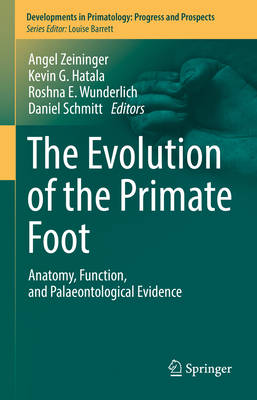
- Afhalen na 1 uur in een winkel met voorraad
- Gratis thuislevering in België vanaf € 30
- Ruim aanbod met 7 miljoen producten
- Afhalen na 1 uur in een winkel met voorraad
- Gratis thuislevering in België vanaf € 30
- Ruim aanbod met 7 miljoen producten
Zoeken
The Evolution of the Primate Foot
Anatomy, Function, and Palaeontological Evidence
€ 305,45
+ 610 punten
Omschrijving
The human foot is a unique and defining characteristic of our anatomy. Most primates have grasping, prehensile feet, whereas the human foot stands out as a powerful non-grasping propulsive lever that is central to our evolution as adept bipedal walkers and runners and defines our lineage. Very few books have compiled and evaluated key research on the primate foot and provided a perspective on what we know and what we still need to know. This book serves as an essential companion to "The Evolution of the Primate Hand" volume, also in the Developments in Primatology series. This book includes chapters written by experts in the field of morphology and mechanics of the primate foot, the role of the foot in different aspects of primate locomotion (including but not limited to human bipedalism), the "hard evidence" of primate foot evolution including fossil foot bones and fossil footprints, and the relevance of our foot's evolutionary history to modern human foot pathology.
This volume addresses three fundamental questions:
(1) What makes the human foot so different from that of other primates? (2) How does the anatomy, biomechanics, and ecological context of the foot and foot use differ among primates and why? (3) how did foot anatomy and function change throughout primate and human evolution, and why is this evolutionary history relevant in clinical contexts today?
This co-edited volume, which relies on the insights of leading scholars in primate foot anatomy and evolution provides for the first time a comprehensive review and scholarly discussion of the primate foot from multiple perspectives. It is accessible to readers at different levels of inquiry (e.g., undergraduate/graduate students, postdoctoral research, other scholars outside of biological anthropology). This volume provides an all-in‐one resource for research on the comparative and functional morphology and evolution of the primate foot.
This volume addresses three fundamental questions:
(1) What makes the human foot so different from that of other primates? (2) How does the anatomy, biomechanics, and ecological context of the foot and foot use differ among primates and why? (3) how did foot anatomy and function change throughout primate and human evolution, and why is this evolutionary history relevant in clinical contexts today?
This co-edited volume, which relies on the insights of leading scholars in primate foot anatomy and evolution provides for the first time a comprehensive review and scholarly discussion of the primate foot from multiple perspectives. It is accessible to readers at different levels of inquiry (e.g., undergraduate/graduate students, postdoctoral research, other scholars outside of biological anthropology). This volume provides an all-in‐one resource for research on the comparative and functional morphology and evolution of the primate foot.
Specificaties
Betrokkenen
- Uitgeverij:
Inhoud
- Aantal bladzijden:
- 527
- Taal:
- Engels
- Reeks:
Eigenschappen
- Productcode (EAN):
- 9783031064357
- Verschijningsdatum:
- 8/12/2022
- Uitvoering:
- Hardcover
- Formaat:
- Genaaid
- Afmetingen:
- 156 mm x 234 mm
- Gewicht:
- 925 g

Alleen bij Standaard Boekhandel
+ 610 punten op je klantenkaart van Standaard Boekhandel
Beoordelingen
We publiceren alleen reviews die voldoen aan de voorwaarden voor reviews. Bekijk onze voorwaarden voor reviews.







